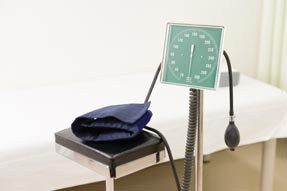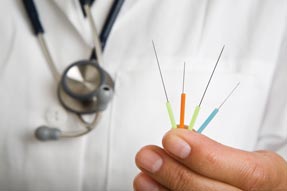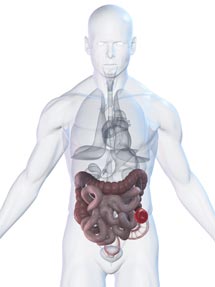Shifting standards for hypertension
New hypertension guidelines are being developed by the American Heart Association (AHA) and the American College of Cardiology (ACC) that will incorporate new study results. At issue is how these results apply to the many types of patients who walk through the office door, including those with diabetes.
Although recent guidance has migrated a bit away from aggressive treatment of mild hypertension, the cardiovascular benefits achieved through SPRINT (Systolic Blood Pressure Intervention Trial) will likely alter that stance. But doctors don't necessarily agree as to what extent.
The large-scale randomized study, which targeted 9,361 adults age 50 and older with cardiovascular risk factors and a systolic reading of at least 130 mm Hg, found that using medication to target a systolic reading of less than 120 mm Hg versus less than 140 mm Hg provided significant cardiovascular protection. Patients in the intensive-treatment group experienced 25% fewer cardiovascular events—1.65% annually versus 2.19% in the standard-treatment group—after a median follow-up of 3.26 years, according to the results published in the Nov. 26, 2015, New England Journal of Medicine.

“One trial doesn't usually change practice,” said Sandra J. Taler, MD, FACP, a hypertension expert who is a professor of medicine and a physician at the Mayo Clinic in Rochester, Minn. “We look at multiple trials. But SPRINT was a really good trial. And it's not going to be repeated any time soon, I don't think. I think we have to take the results pretty seriously.”
Those cardiovascular benefits, considered so significant that the study was stopped early in the fall of 2015, added crucial data to an ongoing risk-benefit discussion regarding how far blood pressure should be lowered in older adults. The JNC 8 guidelines, published 2 years prior to SPRINT, had recommended raising the systolic treatment threshold for adults age 60 and older to 150 mm Hg, citing the lack of randomized trial guidance for lower targets, along with concern about medication side effects.
New hypertension guidelines are being developed by the American Heart Association (AHA) and the American College of Cardiology (ACC) that will incorporate the SPRINT results and might be available as early as year's end, according to Dr. Taler, a member of the guideline committee. But meanwhile, what changes should doctors make? At issue is how these results apply to the many types of patients who walk through the office door, particularly given the various exclusions in the study, most notably patients with diabetes.
David Reuben, MD, FACP, chief of the division of geriatrics at the University of California, Los Angeles, noted that likely none of his patients fit the SPRINT criteria, enumerating the many exclusions: prior stroke, end-stage kidney disease, a prior cardiovascular procedure, and symptomatic heart failure within the last 6 months, among others.
“The issue is not the validity of the study; it was a really good study,” Dr. Reuben said. “The issue is really the generalizability. I think that the bottom line is that it [whether to treat more aggressively] is still a case-by-case decision here.”
But Raymond Townsend, MD, a JNC 8 guidelines author and also a SPRINT investigator, called the SPRINT findings “a game changer” in terms of more aggressive systolic goals for that 60-plus age group. The results are compelling enough that doctors should consider action now with their older patients, as long as they don't have diabetes or chronic kidney disease, Dr. Townsend said.
“The first thing I would be doing is getting my 60-plus-year-olds down below 140 [mm Hg],” he said. “That's the first step.”
Findings and caveats
Not everyone who participated in the study reached the target levels, with a mean systolic reading of 121.5 mm Hg in the intensive-treatment group and 134.6 mm Hg in the standard cohort across the 3.26 years. To achieve that reduction, the intensive group took an average of 1 more medication, 2.8 drugs versus 1.8 with the standard approach.
The study also didn't find any increase in injurious falls in the intensive group. But slightly more than one-third of participants in both groups experienced at least 1 serious adverse event. Those events that occurred more frequently in the intensive group included hypotension, syncope, electrolyte abnormalities, and acute kidney injury or acute renal failure.
Despite his enthusiasm, Dr. Townsend noted that the study wasn't a home run. The 25% reduction in the primary outcome was based on the timing to the first occurrence of 5 cardiovascular outcomes: myocardial infarction, acute coronary syndrome, stroke, heart failure, or cardiovascular death. While the payoff in terms of reduced heart failure and cardiovascular death was clear-cut, the remaining 3 didn't reach statistical significance, Dr. Townsend said. “It's not 3 cheers for 120 mm Hg systolic. It's 2 out of 5 cheers for 120 mm Hg.”
Dr. Townsend also highlighted the mixed picture regarding kidney effects. Among those participants with chronic kidney disease from the start, there wasn't a significant difference in kidney-related effects, including end-stage renal disease or a decrease in estimated glomerular filtration rate (eGFR) of 50% or more. But there was a statistically higher rate in those without kidney disease who saw a decline of eGFR of 30% or more. Researchers wrote that there was no evidence of permanent kidney injury with the 120 mm Hg systolic goal but that “the possibility of a long-term adverse renal outcome cannot be excluded.”
Thus, part of the price for pushing for lower systolic readings will be closer monitoring, including office visits, as medication is adjusted, Dr. Townsend said. “And it's going to require a little bit more intense monitoring for acute kidney injury and electrolyte abnormalities.”
Also confounding from a clinical practice standpoint is the lack of diabetic participants, said Jeremy Sussman, MD, an assistant professor at the University of Michigan and the Veterans Affairs Ann Arbor Healthcare System. “The patients who I think are most stuck in the middle now are the patients with diabetes,” he said.
Diabetic patients were not included in SPRINT in an attempt to settle the ongoing debate over whether a 120 mm Hg systolic target achieved a statistically significant cardiovascular benefit compared with 140 mm Hg, Dr. Sussman said. The results of the ACCORD (Action to Control Cardiovascular Risk in Diabetes) study had perplexed many lower-is-better proponents, Dr. Sussman said. Still, diabetes is undoubtedly a cardiovascular risk factor, he said.
For now, Dr. Townsend plans to continue to use 140 mm Hg as a target for his patients with diabetes. “So far as I know, ACCORD is still the reigning study,” he said. Ideally a large-scale study should be conducted in patients with diabetes, comparing 120 mm Hg to 140 mm Hg.
However, Dr. Taler, the Mayo Clinic hypertension expert, said doctors shouldn't wait that long. She cited an editorial published in the same issue of the New England Journal of Medicine as the SPRINT results, which analyzed the findings from SPRINT separately and in combination. The outcomes were generally consistent, the authors wrote, although the ACCORD trial wasn't nearly as large and thus had less statistical power, and its primary outcome included a higher proportion of cardiovascular events that are less sensitive to blood pressure reduction.
In the wake of the SPRINT findings, Dr. Taler personally believes that patients with diabetes should be treated to systolic levels below 140 mm Hg.
“Diabetes if anything is higher risk than not being diabetic,” she said. “If this treatment was effective for people at high cardiovascular risk, including people with some degree of chronic kidney disease, then it's very difficult for me to say that diabetics should not be treated in a comparable manner.”
Measuring and dialing back
In the office, doctors might not have to push for a reading as low as 120 mm Hg to help their patients, given that in-office readings tend to run higher than clinical studies that use an optimal measurement protocol, Dr. Townsend said.
“It's not a trivial amount,” Dr. Townsend said, describing the difference as roughly 10 points. “If you measure 121 mm Hg [systolic] in SPRINT, you are going to be 131 mm Hg in the physician's office later that day or earlier that day,” he said. Dr. Townsend's suspicion, which he stresses is no more than that, is that the ACC/AHA guidelines will recommend a target higher than 120 mm Hg.
But doctors also should redouble their efforts to get as accurate an in-office reading as feasible, given the heightened focus on systolic pressure, Dr. Townsend said. The preferred method is to take multiple readings after the patient has rested in a seated position with the back supported for roughly 5 minutes. The patient shouldn't be talking, should have an empty bladder, and should have had “no recent cigarettes or caffeine,” he said.
Both Dr. Townsend and Dr. Taler recommend that primary care doctors consider investing in an automated blood pressure unit. If the unit is located in a quiet area away from the exam rooms, a single device could be used on many patients. Even chitchat with a medical assistant can potentially boost blood pressure, Dr. Townsend said. “The less you involve a human in the blood pressure measurement, the lower and probably more accurate the blood pressure reading may be,” he said.
From Dr. Sussman's perspective, though, the systolic reading is the least important factor in determining whether to start a patient on medication or to add a drug. Similar to treating high cholesterol, Dr. Sussman's first criteria is to assess his patient's overall heart and stroke risk. Then he will weigh the potential side effects, including cost, of the drug he's considering and how that might impact the patient's quality of life. His final concern, he said, is the reading on the monitor.
In SPRINT, Dr. Sussman pointed out, the participants' initial systolic pressures ranged quite high, from 130 mm Hg to 180 mm Hg, and yet the intensive treatment group still reaped a 25% reduction in cardiovascular events.
As they monitor their patients, doctors also need to be prepared to dial back on medication if blood pressure swings too low, Dr. Sussman said. He coauthored a study, published in December 2015 in JAMA Internal Medicine, which found that 18.8% of 81,226 older patients with diabetes whose blood pressure dropped very low, defined as below 120/65 mm Hg, had their medications reduced in either number or dosage. Among those with a low reading whose medication wasn't changed, an elevated reading of 140/90 mm Hg or higher was detected in just 0.2% of cases during the subsequent 6 months, researchers found.
It's not clear why doctors are slow to reduce medication, Dr. Sussman said. One factor might be the tracking of blood pressure by quality initiatives. Thus a doctor might decide to shoot for a goal of 120 mm Hg to get the patient routinely under 140 mm Hg in the office, he said.
Plus, there are interpersonal dynamics likely at play, Dr. Sussman said. It can take some time for a doctor to identify the right combination of drugs, he said. “It really is hard to step back,” he said. “To take that step back and say, ‘Actually, that was useful for you in the past, but it's not anymore.’ That can be a very difficult conversation.”





